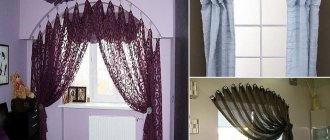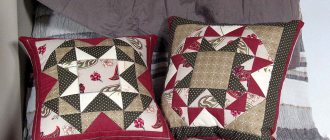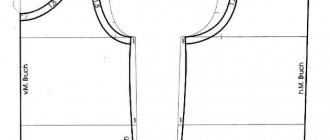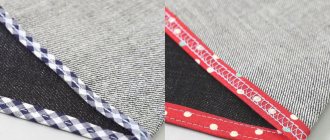Tulle is often chosen to decorate windows. This is a light and weightless curtain that gives a special coziness to the interior. Tulle does not always have the appropriate length. If you decide to hem tulle at home, then you should do this work carefully. This material is quite capricious and requires careful handling. You can hem the tulle by hand or using a sewing machine. In the second case, the seam will be neater. From this article you will learn how to hem tulle yourself at home.
How to align the edges of tulle for cutting and hemming?
Now in all stores and even markets there are points that specialize in hemming curtains and tulles. After all, you usually purchase canvas per meter with a standard height. But, unfortunately, not everyone can boast a ceiling height of 3.2 or 2.9 m. Namely, these values are the standard length of tulle or curtains. Accordingly, the canvas will have to be shortened.
This can be done at home or in a studio. But remember that the work of shortening and sewing the braid can cost from 10 to 25% of the total cost of the tulle. Accordingly, you can save a lot if you do all the work yourself.
Instructions:
- Typically, tulle is made from fabric that frays. Therefore, it is quite difficult to align the edge. But there is another method.
- It is necessary to mark the place where you need to cut and make an incision 2-3 cm long.
- Now just grab the tulle by two edges and tear it. The most interesting thing is that when you tear the tulle, the edge turns out to be perfectly smooth and rounded. It is much easier to hem it later.
- There is another method to align the edges. It is often used by builders to level walls. You need to immediately sew on the braid and hang the tulle on the cornice. After this, a thread is sewn on top and a weight is hung. These marks can be used to cut.
How to align the edges of tulle for cutting and hemming?
Designer decoration
When the Roman blinds and veil are ready and you have hung them on the window, then you should think about how to decorate them beautifully and make them even better. Curious and unobtrusive decor has never harmed a single concept. Besides, here too the desire to do something with your own hands will only help you. So, this design will help you make your curtains more beautiful:
- Inserts of laces and pendants;
- Availability of chains;
- Beads and bows;
- Bead weaving.
Related article: What glue is best for gluing ceiling tiles
The veil for curtains can also be decorated with various ribbons. But, if initially the fabric contains designs and inserts made of gold or guipure, then any decor will be superfluous and it is better not to do anything.
Having mastered sewing once, you will learn forever, so don’t be lazy. In addition, you can always start learning how to sew lambrequins and other lush elements and improve your skills. And well-made curtains are always a great decoration of the house and a source of pride for the owners of the monastery.
How to cut and shorten tulle evenly if it is long?
Nowadays, more and more buyers do not trim curtains, but use a variety of hems. This will allow you to rip off the tape and lengthen the curtains if necessary. But if you do not want to do this, it is advisable to shorten the tulle after it has hung on the curtain rod for 3 days. In this case, the canvas is completely straightened.
Instructions:
- Once your curtains have hung, you can trim them.
- To do this, it is worth considering the features of your room. Often the floor and ceiling are curved, which is why the height of the room is different at certain points.
- In this case, it is worth noting the height at the beginning, at the end and in the middle. After that, print the average value.
- It is advisable to draw a line using a ruler. Often curtains are cut using a stationery knife.
- To do this, the ruler is placed on the curtain and drawn with a knife.
How to cut and shorten tulle evenly if it is long?
Tulle of various lengths in the interior - 50 photos:
PreviousCurtainsRules for washing curtains in a washing machine: mode, temperature
Next
CurtainsDescription of cobweb tulle: photos in the interior, reviews
What threads should I use to hem tulle?
The most commonly used is polyester. The threads should be thin and match the color of the tulle. Nowadays, hardware stores have a huge selection of threads. Under no circumstances use old cotton threads. They vary in thickness and can cause arrows and puffs to appear. Silk is also often used.
What threads should I use to hem tulle?
How to properly and beautifully hem tulle on top using tape: description, video
Most often, a braid is hemmed on top. This is a wide ribbon with threads and holes for hooks. After the braid is sewn, it is pulled together. This results in a beautiful drapery.
It is best not to cut the length, but to tuck the rest of the fabric on top. After this you can sew on the braid. If desired, the lower part of the fabric flap is hemmed or using binding. Craftsmen often do this, which allows, if necessary, to rip off the braid and lengthen or shorten the tulle. Details in the video.
Seamless ways to shorten tulle
You can quickly shorten long curtains by hand using adhesive tape. Excess fabric will need to be placed between layers of tape and ironed.
If this is your first time working with adhesive tape, experiment on a scrap piece of fabric before you start shortening the curtains.
You can also use special clips to shorten curtains.
How to hem tulle on the sides correctly and beautifully?
This is not as simple a task as it seems. The thing is that when using ordinary threads, the fabric tightens and the result is not very beautiful. That is why initially it is better to stretch the fabric on the sides as much as possible. There are two methods to do this.
Options for hemming tulle on the sides:
- Break off. You need to make a 2 cm deep cut with scissors and simply tear off a piece of fabric. This way you will get a perfectly straight side. Now you can simply overlock it using silk threads.
- Finish with a double stitch. Everything is done very simply. First, the fabric is folded and stitched. After this, it is folded and stitched again. In this way, wavy and uneven sides are avoided.
How to hem tulle on the sides correctly and beautifully?
Processing side cuts
As with the bottom edge, the tulle needs to be worked on the sides. Otherwise, the fabric may begin to fray during use. In addition to all the seams listed above, the classic hem seam is often used. The mesh needs to be folded by 1 cm. It is recommended to bend the organza by 3 cm. The veil can be folded by 2 cm. Most often, the Moscow seam is chosen for processing side sections.
How to properly and beautifully hem tulle with weighting at the bottom?
The tulle is hemmed at the top. There are several options.
Options for hemming tulle with weighting:
- With a fold. The tulle is folded at the top and a fold is made. The bottom of the fold can be trimmed with trim or ribbons.
- Cut off the top. In this case, the excess piece of fabric is cut off and the braid is sewn on top.
- With rings. This option is suitable if you hang the tulle directly on the cornice. In this case, rings are made or ribbons are sewn on.
How to properly and beautifully hem tulle with weighting at the bottom?
Let's look at the material
To process the top edge, you need to hem the curtain to the curtain tape with fasteners. Today there are quite a few varieties of them. In addition to the material of manufacture (transparent or white), the tape for hemming curtains has a number of characteristics:
- The width and number of rows for fastening (loops for hooks). This is convenient, since the fastening strips located in parallel, with a difference of several centimeters, make it possible to additionally adjust the length of the finished hemmed product.
- Depending on the number of gathering threads, a pattern of folds is formed in the upper part of the curtain, on the opposite side of the tape.
- Factor and type of assembly. Using ribbons, you can adjust the richness of the drapery, while the width of the curtain can be reduced from 1.5 to 3 times.
For dense, textured or patterned fabrics, a gathering factor of 1.5-2 times is quite enough: their surface attracts attention with decorative details; additional decoration with abundant drapery is not required for such curtains. But thin, solid materials will look richer and more elegant with rich and deep folds: for them, a gather factor of 2.5-3 times is used.
In the upper part of the curtain, with the help of tape, folds can be formed like an accordion, in a checkerboard pattern, there is a bow type of assembly, radial, etc.
How to hem tulle correctly and beautifully without cutting?
To do this, use the method described above. In this case, there is no need to trim anything. The excess piece of fabric is folded outward and stitched at the fold. Next, a braid is sewn close to the fold. However, the lower part of the frill is not very beautiful. It resembles a ripped edge. In this case, this area is hemmed using tape or tape.
How to hem tulle correctly and beautifully without cutting?
Determining the required length
In order for the result to be positive, it is important to correctly determine the length of the tulle, which will soon decorate your windows, creating a unique atmosphere of comfort, warmth and coziness in the house.
When the sides are already aligned, it is important to correctly, taking into account the allowances, give the tulle the required length. If you need to hem the bottom of the tulle, the steps are similar. Measure 14 cm from the bottom of the fabric and pull out the thread. Having done this, you will see a straight line along the length of the entire edge.
- Measure the length. If you follow the basic rules, it is important to know that the curtain should have a length that is 10-15 centimeters shorter than the total length from the cornice to the floor. A curtain of this length opens easily and does not collect dust from the floor.
- Make marks (with soap, pencil or chalk) on the fabric surface.
- Cut off the remaining fabric.
Important
Make it a straight, even line. If you are not sure of your own eye, draw a straight line.
Are all the steps listed already behind you? Check again to see if everything was done correctly. If everything is correct, proceed to the next steps.
Related article: Manufacturers of paper wallpaper: countries, factories
How to hem tulle correctly and beautifully by hand?
Doing the work manually is not at all easy. But it is still possible to do it. Be patient. If you don’t have a machine and you are not going to take the tulle to the studio, purchase fabric with a weighting agent.
Instructions:
- At the very beginning, the side seams are processed. The tulle is folded over once and sewn with a “forward needle” seam.
- After this, the side tulle is folded again and stitched with exactly the same seam. After the first filing, it is advisable to smooth the fabric. This will completely line up the side seam and it will be perfectly even.
- Next, you need to figure out what to do with the length. The bottom of tulle with weighting cannot be cut off. In this case, you can cut off the rest of the fabric at the top or simply fold it outward. After this, the braid is sewn on, and the bottom of the resulting frill is decorated with trim.
How to hem tulle correctly and beautifully by hand?
The first important nuances
Before you start doing the work, you need to understand what kind of voile curtains you want for the kitchen. The location of the room and functional features decide here:
- It is best to keep sewing in the kitchen as simple as possible. Minimalism is appropriate here, and lush lambrequins will not be able to absorb grease and kitchen gas - it’s easier to wash;
- You need to select interesting themes for the nursery so that the child does not get bored. But you should also avoid excessive pomp;
- Curtains for a living room or bedroom require more thought, since this is an important step and you spend most of the time in this room. The finished version should fit harmoniously into the overall picture of the room and not go beyond.
If you are afraid to make curtains from a veil with your own hands or are afraid that it will not work out well, it is better to choose a simple model for yourself in advance. The material itself, lightness and airiness, look good even in a simple version. If you want to create a brighter room, then you should choose the appropriate fabric, or immediately add light and fluffy lambrequins in a bright contrasting color to the white veil.
Related article: Beige wallpaper in the living room interior: 35 photos
How to process the edges of nylon tulle, mesh and organza: tips
If the tissue is very thin, then there may be puffs left at the points where the needle is inserted. This is especially true for sewing machines. To process thin tulles, it is worth purchasing special needles. But you can do without filing at all. Of course, the edges look untidy, but this is easy to fix with adhesive tape.
Instructions:
- This tape is sold in hardware stores and is a paper strip coated with a mesh of hot-melt adhesive.
- You need to cut the edge and fold it, iron it. This is necessary in order to form an even fold and bend.
- Next, an adhesive mesh is inserted, from which you should not tear off the paper. An iron is drawn along the glue line.
- Next, you need to carefully remove the paper, fold the edge and iron it again. Do not use a damp cloth while ironing. Everything should be dry.
- Of course, this method is not the best, since after several washes the glue comes away from the fabric and you have to smooth the edges again.
How to process the edges of nylon tulle, mesh and organza: tips
As you can see, tulle is a beautiful fabric with which you can decorate a room. All work on hemming tulle can be done at home. It is not necessary to use threads.
Moscow seam
This seam is very popular and is performed using a sewing machine. The width of the hem is small, so that the fabric does not lose its lightness.
For hemming organza tulle and mesh, it is better to choose thread No. 40 and thinner. If the fabric is translucent, the thread color should be slightly lighter than the tulle. This way they will be almost invisible.
Bottom processing is performed in the following sequence:
- Turn the fabric 5 mm.
- Iron the hem.
- Sew the fabric 0.2 cm from the edge.
- Cut off the excess fabric 0.2 cm from the created stitch.
- Tuck the tulle.
- Run the iron along the hem again.
- Sew the fabric with an indentation of 2 mm from the first line.
This method of shortening curtains will save material on the hem.











